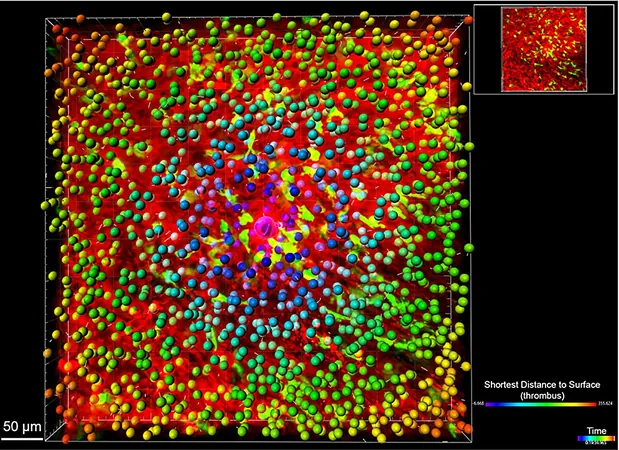
Revolutionizing Drug Development: Light-Driven Reactions Open New Pathways
2025-03-24
Author: Siti
Introduction
A team of innovative researchers from Indiana University and Wuhan University has unveiled a groundbreaking chemical process set to transform the landscape of pharmaceutical development. Their study, published in the prestigious journal *Chem*, introduces a novel light-driven reaction that promises to simplify the synthesis of tetrahydroisoquinolines—vital chemical building blocks integral to modern medicine.
Importance of Tetrahydroisoquinolines
Tetrahydroisoquinolines are not merely abstract concepts; they are crucial components in the formulation of treatments for severe conditions such as Parkinson’s disease, various cancers, and cardiovascular ailments. These compounds are prominently featured in popular medications, including pain relievers and antihypertensives, and are prevalent in nature, found in certain plants and marine organisms.
Traditional Synthesis Methods
Traditionally, the synthesis of these compounds has adhered to conventional chemical methods that often come with significant limitations and challenges. However, the collaborative effort led by chemists like Professor Kevin Brown, the James F. Jackson Professor of Chemistry at Indiana University, alongside Professors Xiaotian Qi, Wang Wang, and Bodi Zhao from Wuhan University, marks a transformative departure from these entrenched practices.
The Power of Light in Chemical Reactions
The essence of this research lies in the harnessing of light to initiate a process known as photoinduced energy transfer. This revolutionary methodology triggers a controlled reaction between sulfonylimines (chemical compounds featuring sulfur and nitrogen) and alkenes (compounds containing carbon-carbon double bonds), ultimately generating tetrahydroisoquinolines in a more efficient manner than ever before. This approach not only opens avenues for unprecedented molecular structures but also enables the creation of complex molecules that were previously considered challenging or impossible to synthesize.
Professor Brown emphasized the significance of using light-activated catalysts—special molecules that accelerate reactions without being consumed in the process. He likened traditional synthesis methods to "cooking food with a blowtorch instead of a stove," highlighting that the harsh conditions typically employed can lead to undesirable byproducts. The new light-based method allows for cleaner, more efficient reactions while minimizing side reactions that could compromise the purity of the final compound.
The research team also discovered that minute adjustments in the positioning of electrons within the reactants could greatly influence the outcome of chemical reactions. This precision allows for selectively producing the desired compounds, which is crucial in pharmaceutical applications, where even minor changes in molecular structure can lead to ineffective or harmful drugs.
Broader Implications for Medicine and Beyond
The broader implications of this cutting-edge research extend well beyond pharmaceutical chemistry. "The capability to generate a diverse array of tetrahydroisoquinoline-based molecules means medicinal chemists can explore novel drug candidates for challenging diseases," Professor Qi noted. With many diseases currently lacking effective treatments, this innovative methodology could hasten the discovery of new and superior drugs.
Moreover, this novel approach holds promise across various industries dependent on fine chemical production. In agriculture, for example, the same chemical principles could be utilized to develop enhanced pesticides or fertilizers. In the field of materials science, it could facilitate the creation of revolutionary synthetic materials with improved durability and resistance, which could benefit sectors like aerospace, automotive, and electronics significantly.
Future Directions
As the research team prepares to refine their techniques, they aim to investigate additional applications of their method to extend its potential further. The possibility of collaborating with pharmaceutical companies to test and implement this cutting-edge technology in drug production could pave the way for breakthroughs that significantly improve patient outcomes.
"This approach provides chemists with an essential new tool," Professor Brown asserted. "We are optimistic that it will catalyze the development of enhanced therapies that can have a profound impact on global health."
Conclusion
As the field of photochemistry evolves, advancements like these herald a new era in the synthesis of medicines and essential chemicals—one characterized by faster, cleaner, and more efficient production methods that could change lives. Researchers and industry professionals alike are eagerly anticipating the potential transformations looming on the horizon.



 Brasil (PT)
Brasil (PT)
 Canada (EN)
Canada (EN)
 Chile (ES)
Chile (ES)
 Česko (CS)
Česko (CS)
 대한민국 (KO)
대한민국 (KO)
 España (ES)
España (ES)
 France (FR)
France (FR)
 Hong Kong (EN)
Hong Kong (EN)
 Italia (IT)
Italia (IT)
 日本 (JA)
日本 (JA)
 Magyarország (HU)
Magyarország (HU)
 Norge (NO)
Norge (NO)
 Polska (PL)
Polska (PL)
 Schweiz (DE)
Schweiz (DE)
 Singapore (EN)
Singapore (EN)
 Sverige (SV)
Sverige (SV)
 Suomi (FI)
Suomi (FI)
 Türkiye (TR)
Türkiye (TR)
 الإمارات العربية المتحدة (AR)
الإمارات العربية المتحدة (AR)